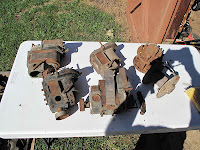Do this outside, it makes explosive Hydrogen Gas, don't blow up your house.
You're plugged into 110 Volts AC, be careful it can kill.
Don't use Stainless Steel for anodes. Keep the bath safe.
For small parts I've started with a 5 gallon mud bucket. For anodes (these get slowly consumed in the process) I used some of the 20 gauge mild steel I bought for the control horns on the WACO NINE. I had cut up the remaining 4'x8' sheet into blanks 18" x 8" so I just split some of them 4" wide. That allowed me to bend a leg on the end to form an anode covering the bottom of the bucket as well as the sides. Don't use a steel bucket because it will slowly dissolve in the process, not good.
To hold the "L" shaped pieces in place I punched 5 holes in the bucket and a hole in each anode so they can be bolted to the bucket to hold them in place. The bolts also provide a way to wire them together. The bolts are not in the water but they are in a wet environment so I used galvanized bolts (1/4") with a star washer under the head for better electrical contact. I put a stack of washers and a nut behind the anode to space it out from the bucket. The nut is to assure the star washer gets compressed. On the outside of the bucket there is a washer then the wire terminal, star washer, second terminal, and then a nut to hold the connections tight. I used wing nuts because I had them.
For a place to connect the positive lead, from the charger, I made a pig tail which connects to both ends of the wiring. The lead didn't clip to it as good as I wanted so I'll figure out a better pig tail.
With the bucket made I then calibrated it to hold 4 gallons of water then added 1 Tablespoon of washing soda per gallon. I don't think the water could hold that much. I suspect half of that would have done the job. I need to do some experimenting with a jug of water to see at what concentration the pH stops changing. I'm also curious how much temperature affects the process. With winter coming I may be in trouble doing this out of doors.
Here's my first rusty part (rudder hinge strap from the WACO NINE). The wire loop made a convenient way to hang the part but I should have used stranded wire. Solid wire is stiffer than the spring in the clip.
We have bubbles! It's working! Very Cool.
On thing I like about using this part is that the surface area is easy to calculate. It's a strip of .050" steel 1" wide, 6" long, with 2 holes 1/4" diameter with a total surface of 12.2 sq. in. With a current flow at 6 volts of .58 amps that's .0477 amps per sq. in.
After 24 hours there is still some rust in the pitted areas, especially on the inner side. A quick hand scrubbing with a fine wire brush cleaned off the Black Oxide, but this part needs more rust removed.
I re-positioned the part so it's tipped at an angle to give all surfaces a better line of site to the anodes. I also increased the voltage to 12 volts. The bubbles are going strong.
After another 24 hours and a light scrubbing with the wire brush under running water the part has no more visible red rust. This part is to pitted to use but it cleaned up nice.
Time to get some engine parts in this bucket.

































